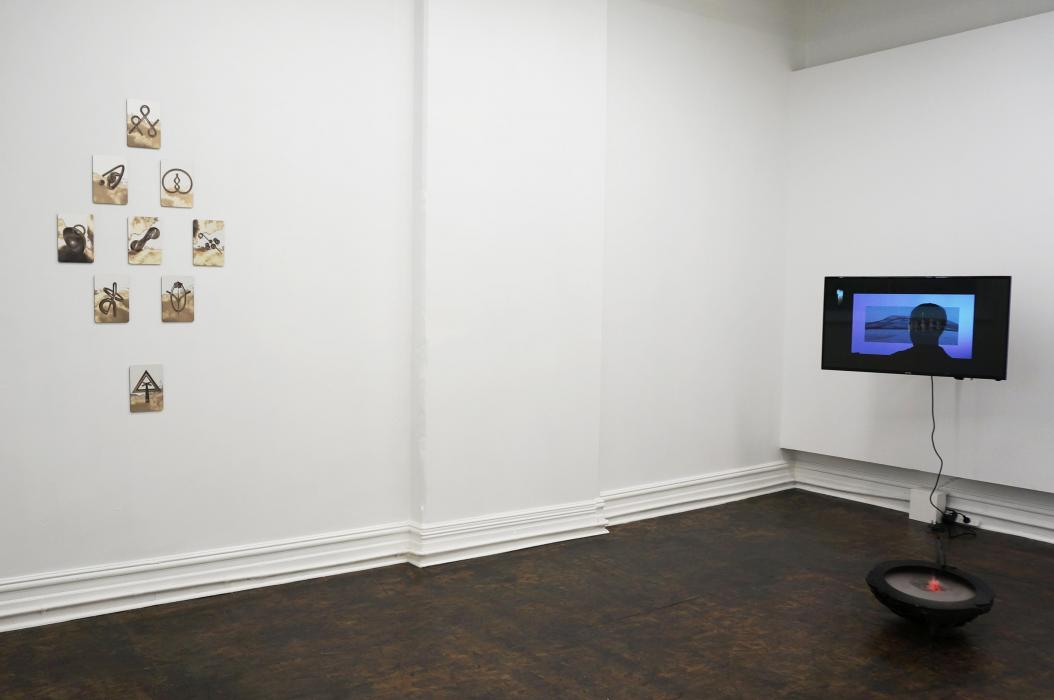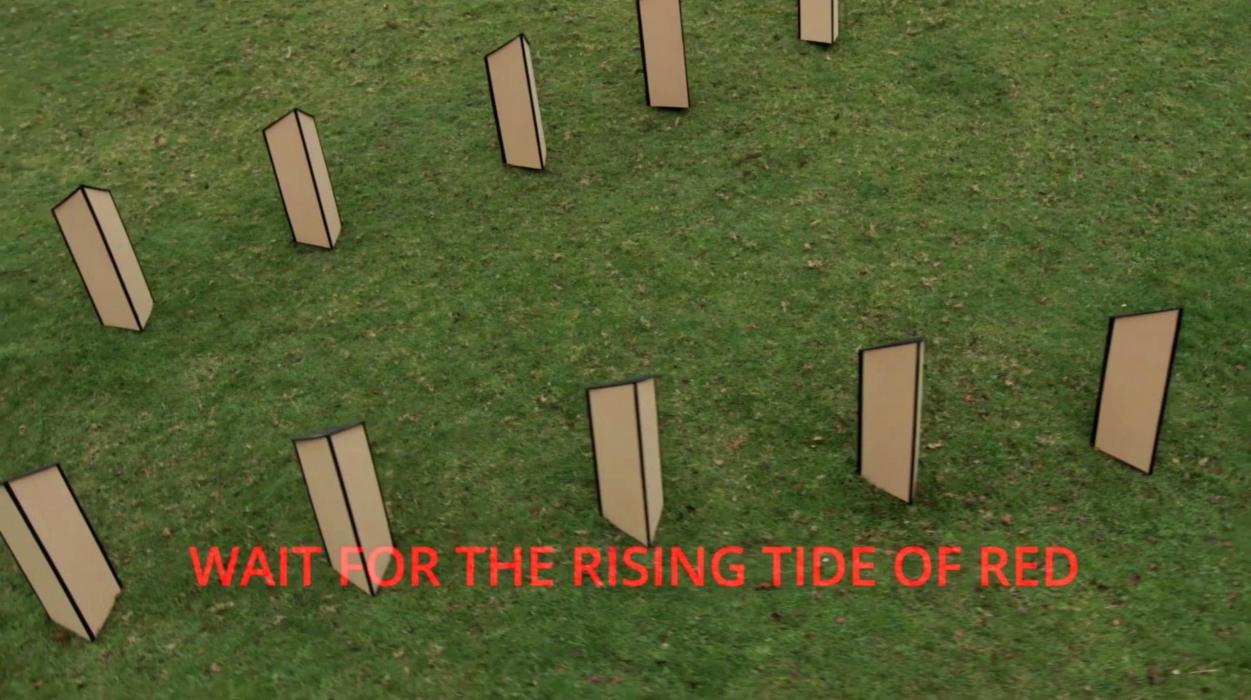Algorithmic Chicanery—Lightspeed Spirituality, Jesse Bowling and Samuel Jackson
The works of Algorithmic Chicanery—Lightspeed Spirituality, a collaboration between Jesse Bowling and Samuel Jackson, appear mysterious and slightly unsettling at first glance. Imbued with a vague kind of mystical, yet also futuristic significance, each assemblage hints at covert rituals and associated occult knowledge.
The practice of occultism (from the Latin word occultus, ‘clandestine, hidden, secret’) has traditionally involved hidden information that is decipherable only to certain informed people.[1] This esotericism is arguably also a feature of the art found in Cool Change Contemporary, the newly opened and very hip artist-run initiative in the Bon Marché Arcade, Perth. As Sheridan Coleman notes, the exhibitions of Cool Change cater to ‘the initiated’; that is, artists and audiences who are familiar with the distinct language, aesthetics, and theories of experimental contemporary art (which can often seem bewildering to outsiders).[2]
Found in Gallery 1 of the space, Algorithmic Chicanery extends our initiation (and bewilderment) into the realm of ‘lightspeed spirituality’. The works of Bowling and Jackson conjure up Western esotericism and New Age mysticism—the worlds of spiritual transformations, life forces, causality, rituals, mysteries, and secrets—within the framework of our current digital climate. In doing so, the artists aim to contest the authority of the technological realm, or in their words, ‘break into the algorithmic encircling of the earth’.[3]
Stepping into the gallery, visitors first encounter their own face reflected in a pristine, aggressively mirrored bathroom cabinet mounted on the gallery wall; one component of Jesse Bowling’s Emotion Algo. (Tell me how I feel, cause I don’t) (2018). Reminiscent of Damien Hirst’s pill cabinets, this open cupboard is lined with four shelves of identical black bottles. Officially printed classifications are visible on the edge of each bottle’s label—‘Client’s Name’, ‘Date’, ‘Dosage’—but the corresponding answers are tiny, scribbled, and can be seen only in mirror-reverse, while the matte glass offers no hints about the contents. However, all is revealed in the accompanying spiral bound booklet, part of the work which acts as a project report explaining Bowling’s methodology.
According to this booklet, Bowling spent 52 days taking selfies and running them through an algorithm which ‘autodetects emotions’.[4] The artist then took these results to a consultation with a naturopath who developed a personal daily treatment regime, which reveals the contents of the bottles to be ‘Bach flower remedies’. For the unfamiliar, Bach remedies contain minuscule amounts of flower essences that are diluted with water in a manner vaguely similar to homeopathic solutions. These remedies are taken orally with the belief that the vibrational energy of each flower will transfer from plant to person and reduce specific negative emotions. Bowling’s booklet offers plenty of information on this practice (some of it copypasted straight from Wikipedia), along with all of Bowling’s selfies, each overlaid with their algorithmic results and paired with the ingredients of the associated flower treatment.[5] The ultimate objective of the treatment plan remains undefined—perhaps in approaching feelings as things to be ‘remedied’, this regime is an attempt to transcend the emotional flux of everyday life. While simplicity is emphasised as a core value of the Bach practice, Bowling’s technologically-augmented version becomes an exhausting, labour-intensive process of continuous monitoring and customisation; like self-help at superspeed.[6]
Using both an alternative therapy and the internet to diagnose, treat, and broadcast the self, Bowling’s work seems to align with a wider digital turn towards the New Age—as seen in the recent rise of online astrological content identified by the New York Magazine as ‘the world’s oldest, and newest, meme trend’.[7] An interesting interaction is generated between the holistic practice of Bach remedies, which were originally formulated in the 1930s through a process of intuition, and the algorithm, regarded as a universally applicable mode of rational artificial intelligence. The algorithmic process flattens Bowling’s emotional range to the confines of quantitative data—but these results are then used to develop a tailor-made, and deeply individualised, fringe ‘medicinal’ treatment. In the catalogue, Bowling suggests that naturopathy and the algorithm ‘both exist within a realm of believability’, challenging the objective authority of automated decision-making and muddling the conventional binary distinctions between vitalism and scientific logic.[8] This is a timely provocation as algorithms exert an ever-increasing influence over our daily lives—from the information we access online, to the jobs we apply for—while the general lack of transparency surrounding their codes and data ensures that their inherent biases remain relatively unexamined.[9]
At the far end of the gallery is Samuel Jackson’s installation Three Canticles of the Oracle (2018), a post-internet assemblage that seems to appropriate and embrace kitsch tropes of the ‘mystical’. A droning, hymn-esque soundtrack plays over a tinny drum machine beat from a flat-screen TV, as it sits above a faux-stone bowl containing a glowing, floating mister that bubbles liquid and fog. The contents of the screen alternate between an unidentified talking head, with the deep, barely coherent voice of a televised witness protection interviewee, and footage of an arrangement of triangular prisms, with text slowly scrolling across the bottom edge of the screen like a karaoke sing-along. Occasionally, snippets from the head’s monologue become decipherable, such as 'unstoppable appropriation' and 'slit our own throats', while the blood-red karaoke text seems to encourage us to sing phrases—including ‘COME HOME TO THE EARTH’—that cannot be heard in the soundtrack. The overall effect of the installation is wholly disconcerting, seeming to exist as a corporate indoctrination video playing in the waiting room of a doomsday cult.
The third and final work of the show is a collaboration between Bowling and Jackson, The word of lightspeed spirituality (2018), which pairs an audio recording with a series of digital images. Printed on brushed aluminium and laid out on the wall like a spread of tarot cards, each image shows a gleaming sci-fi emblem—like a magical symbol rendered in the style of early web graphics—floating on a background of clouds. In the headphones, a man’s voice explains the steps towards ‘lightspeed spirituality’ with the fervour of a self-help guru. Step one, ‘becoming vibrational’, is followed by practices including ‘transcendental obfuscation’, ‘magnetic chanting’, and ‘psionic masturbation’.
This mashup of New Age jargon and futurist buzzwords seems to delight in its opaqueness, while simultaneously attempting to maintain an overall veneer of believability—much like the average TED talk, where the convincing evangelism of the speaker leaves no space for any scepticism. The work appears to parody the kind of computer-generated salvation promoted by today’s disruptive innovators and spiritual entrepreneurs (a quick Google search to find the TEDx talk mentioned in the catalogue reveals that a ‘Netflix of spirituality’ is already in development).[10] Bowling and Jackson gesture to the typical capitalist engagement with spiritualism, in which symbols and phrases are selectively employed to evoke a superficial sense of the meaningful within a futurist agenda. Through the merging of occult vibes and the digital realm, the artists encourage us to consider the Information Age with a little distance, inviting us to reconsider our future at the intersection of high tech, capitalism, and spirituality.
[1] Lifted straight from Wikipedia, https://en.wikipedia.org/wiki/Occult, accessed 16 September 2018.
[2] Sheridan Coleman, ‘Perth’s new gallery: Cool Change Contemporary’, Art Guide Australia, 4 September 2018, https://artguide.com.au/perths-new-gallery-cool-change-contemporary, accessed 16 September 2018.
[3] Jesse Bowling and Samuel Jackson, ‘Chicanery in conversation’, Algorithmic Chicanery—Lightspeed Spirituality catalogue text, https://coolchange.net.au/wp-content/uploads/2018/09/CCCCatalogue_Sept2018.pdf.
[4] The algorithm can be found here: https://algorithmia.com/algorithms/deeplearning/EmotionRecognitionCNNMBP.
[5] All of Bowling’s selfies can be found here: http://jessebowling.space/emotionalgo/.
[6] The Bach Centre, ‘On simplicity’, https://www.bachcentre.com/centre/simple.htm, accessed 24 September 2018.
[7] Dayna Evans, ‘Astrology, the World’s Oldest, and Newest, Meme Trend’, New York Magazine, 18 June 2018, http://nymag.com/selectall/2018/06/astrology-memes-unite-micro-targeting-and-celestial-mythos.html, accessed 16 September 2018.
[8] Jesse Bowling, ‘Chicanery in conversation’.
[9] Simon Elvery, ‘How algorithms make important government decisions—and how that affects you’, ABC News, 21 July 2017, http://www.abc.net.au/news/2017-07-21/algorithms-can-make-decisions-on-behalf-of-federal-ministers/8704858, accessed 24 September 2018.
[10] Zara Stone, ‘How A Spirituality Startup Is Solving Silicon Valley's Religious Apathy’, Forbes, 26 April 2018, https://www.forbes.com/sites/zarastone/2018/04/26/how-a-spirituality-startups-solving-silicon-valleys-religious-apathy/, accessed 16 September 2018.

,%202018,%20algorithm,%20selfie,%20glass%20bottles,%20brandy,%20water,%20flower%20essence,%20mirror%20cabinet,%20spiral%20bound%20booklet,%20de-itok=gC65xJYP.jpg)
,%202018,%20algorithm,%20selfie,%20glass%20bottles,%20brandy,%20water,%20flower%20essence,%20mirror%20cabinet,%20spiral%20bound%20booklet%20ins-itok=ficKAILr.jpg)
,%202018,%20algorithm,%20selfie,%20glass%20bottles,%20brandy,%20water,%20flower%20essence,%20mirror%20cabinet,%20spiral%20bound%20booklet,%20de-itok=S26jh0mY.jpg)


